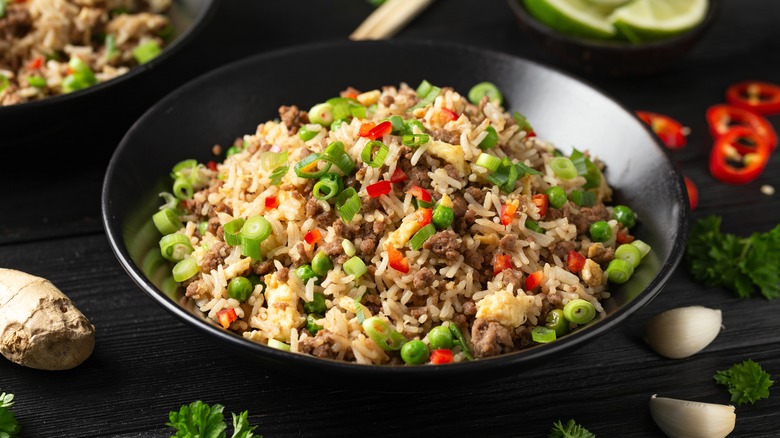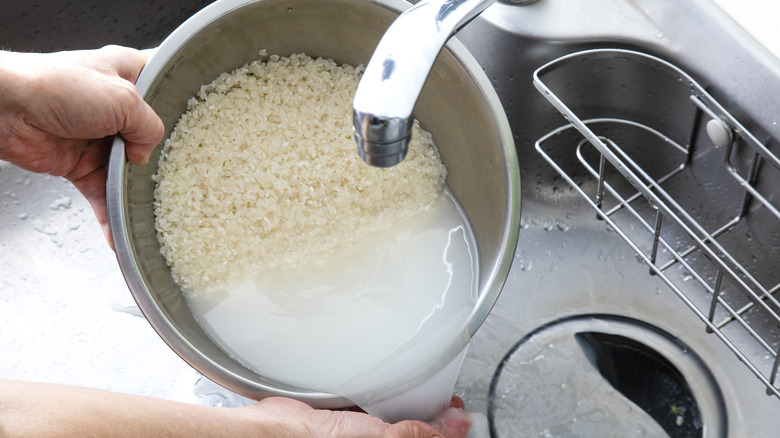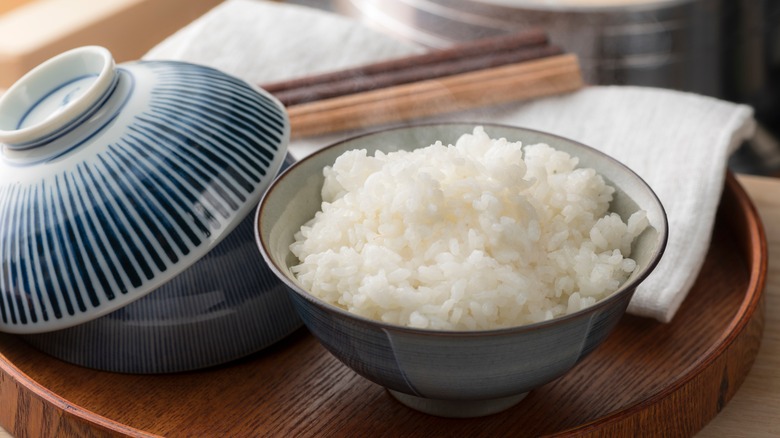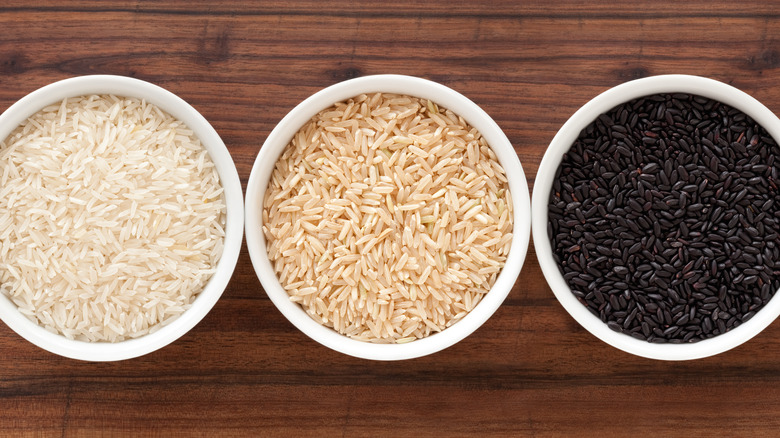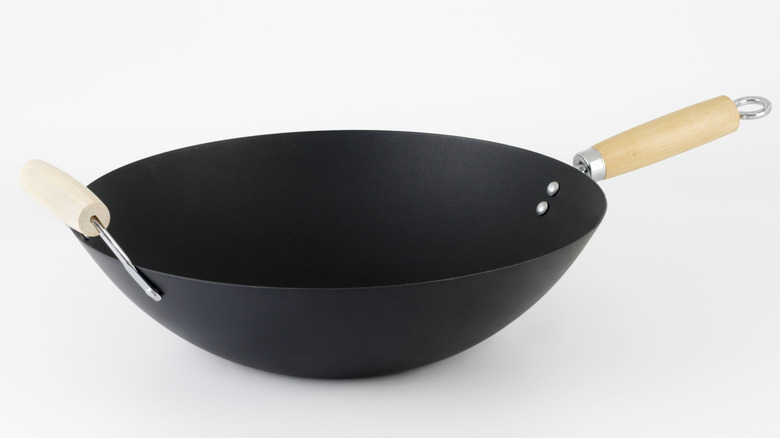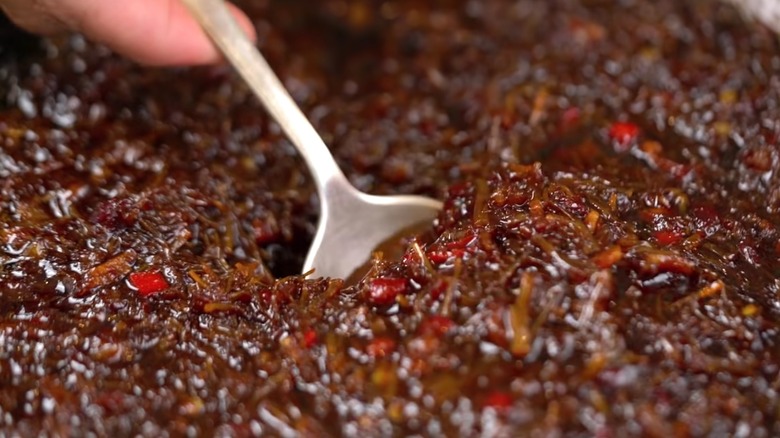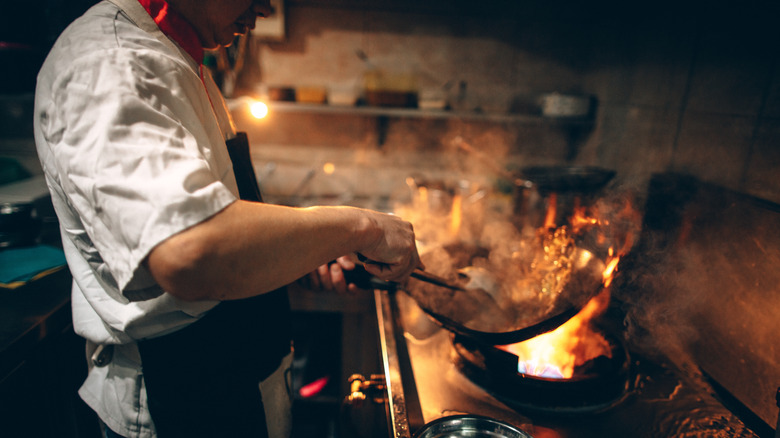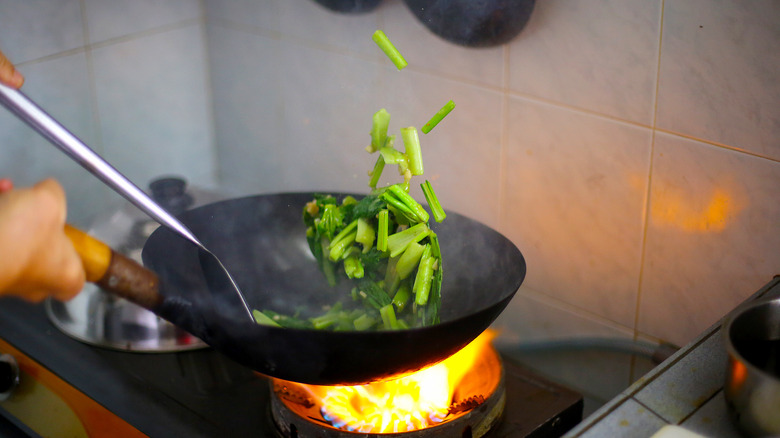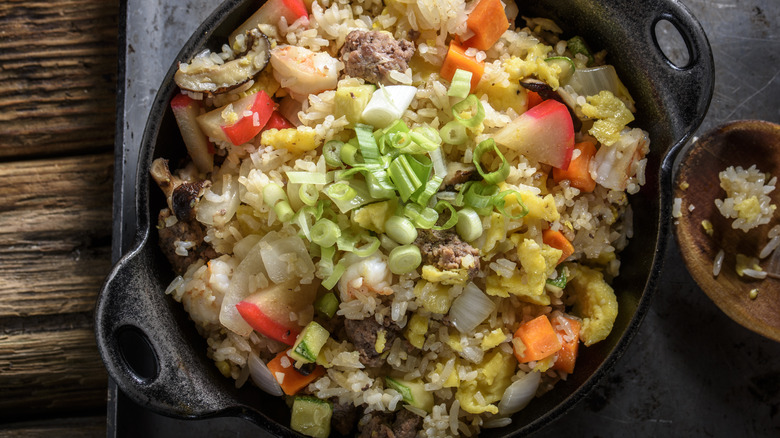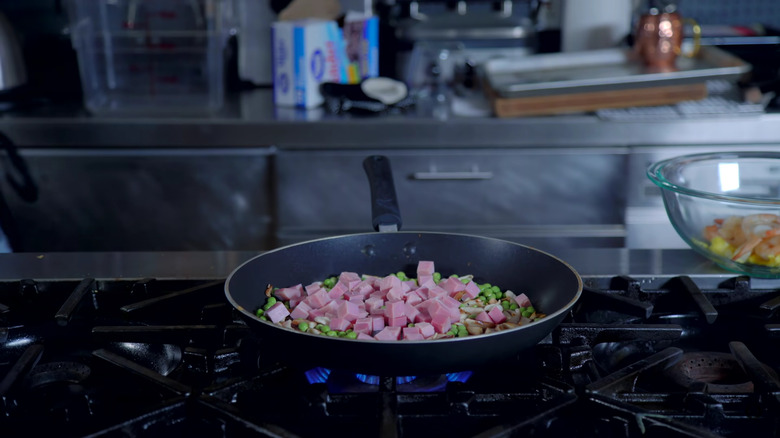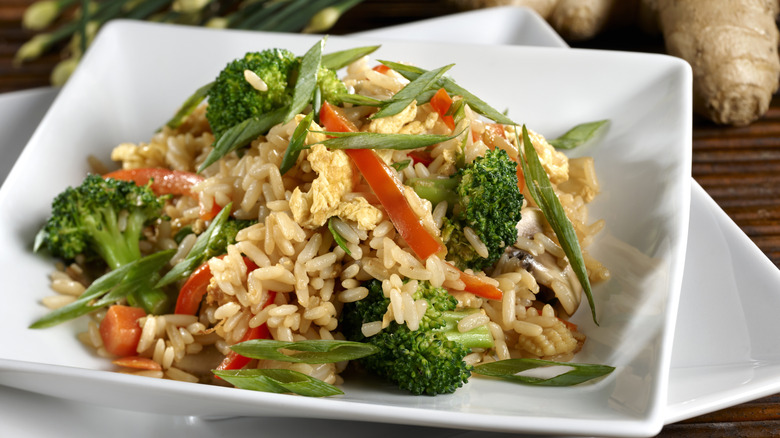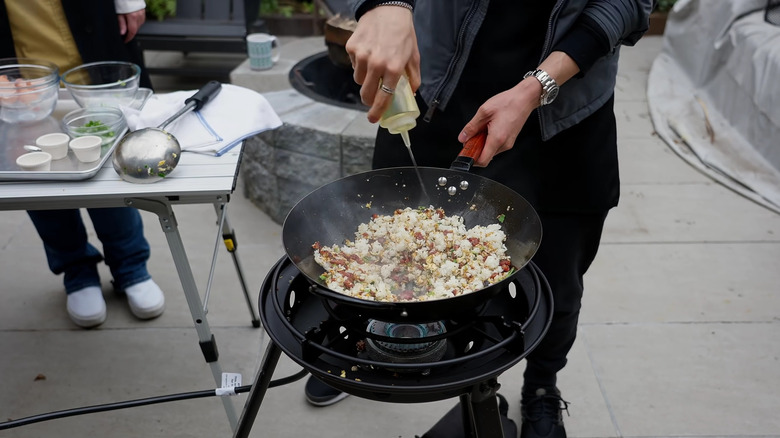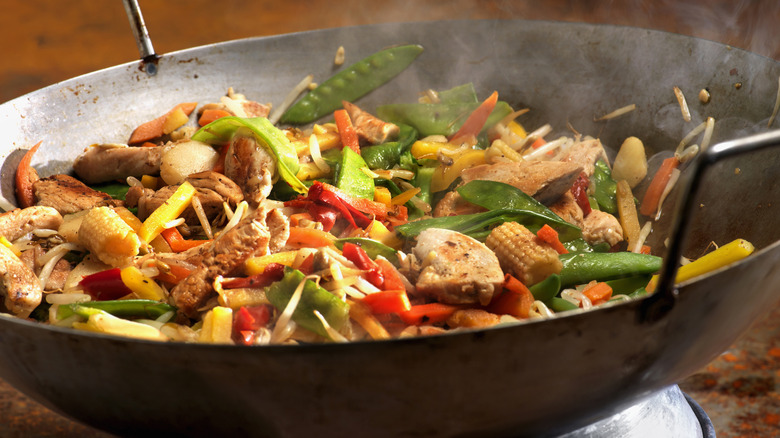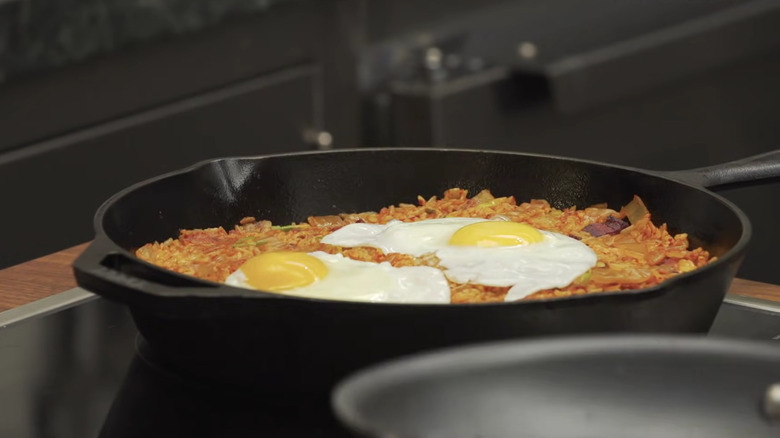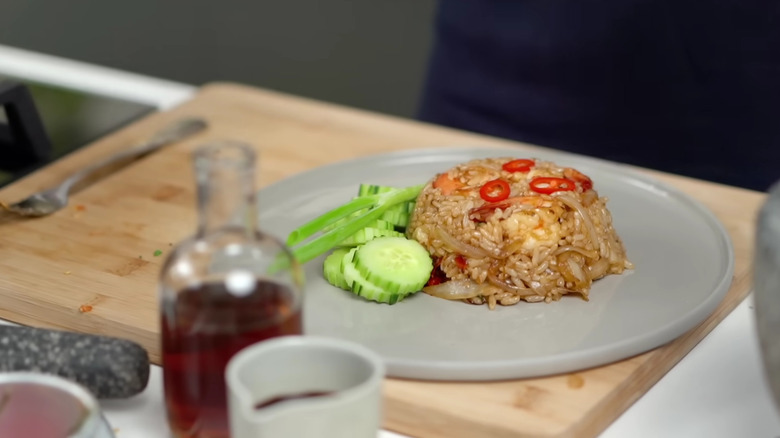14 Reasons Your Homemade Fried Rice Never Tastes As Good As Takeout
Fried rice has been an essential part of China's numerous cuisines since before the north and south of the country were unified in the 6th century. As a dish integral to the vast majority of China's population, it is unsurprising that fried rice was one of the dishes Chinese immigrants first brought to the United States during the 19th and 20th centuries. As with many other Chinese dishes, fried rice was adopted in the U.S. for reasons chef Lucas Sin highlighted to Whetstone: "Fried rice is always a wonderful story of how different flavors and different cultures and different cooking styles come together [...] When people move from country to country or from region to region, they bring with them their ideas of how to cook and their techniques when they aren't able to bring their ingredients."
Today, Chinese American fried rice is a ubiquitous dish served in all manner of restaurants. That being said, takeout fried rice has a special allure; a unique feeling of comfort and indulgence comes when the box's metal foil corners are peeled back and its cloud of fragrant steam is inhaled. While recreating such feelings with homemade fried rice is all but impossible, recreating the dish itself is not.
There are several reasons why your fried rice never tastes as good as takeout. These range from technical errors to the over-enthusiastic use of additional ingredients. Address them and you'll be able to produce excellent fried rice, lack of takeout containers notwithstanding.
1. You're not rinsing your rice before cooking it
Many of us are guilty of not rinsing rice before cooking it. We do this despite hearing that it's an essential step over and over again. Unfortunately, we're going to repeat that mantra because you simply can't get away with not washing your rice when it's going to be used for making fried rice. The reason for this is simple: washing white rice stops it from clumping together.
The mechanics behind this were explained to America's Test Kitchen by scientist Matt Slem: "When you wash the rice, that surface starch kind of separates from the rice, and it stays in the water. When you actually wash, rinse, or soak white rice, it becomes less sticky. And when you cook it up, the kernels of rice separate and get more fluffy."
One of the indicators of good fried rice is individual, well-cooked rice grains. By not clumping together, rinsed rice prevents the dish from adopting an unpleasant, lumpy texture and also ensures that any added ingredients or flavorings become well-dispersed throughout the mixture. Failing to wash your rice, especially if it is white, will result in fried rice that contains clumps of unseasoned rice; a far cry from the loosely grained fried rice good restaurants serve. What's more, the rice's surface starch may end up in the dish itself, transforming its texture into something more akin to risotto than the dry, crisp texture it's renowned for.
2. The rice you're using was freshly cooked
Traditionally, fried rice is made with cooked rice that's leftover from the day before. Using this older rice results in far superior fried rice for the simple reason that it is much drier than freshly cooked rice. Some chefs even spread cooked rice out on a baking tray to dry it out further, ensuring that the finished dish develops a crisp, dry texture. On the other hand, using freshly cooked rice — which is moist, warm, and full of trapped steam — results in fried rice that's wet, sticky, and not at all like versions produced by restaurants.
This is not to say that fried rice can only be made with rice that's cooked the day before. Pre-cooking the rice a few hours before you make fried rice gives ample time for it to cool and dry out, especially if it is spread out on a baking tray.
For those who cannot plan ahead by a few hours, America's Test Kitchen produced a technique for creating freshly cooked rice that boasted a similar texture to pre-cooked, chilled rice. While effective, the technique is by no means simple and still involves a 30-minute chilling period. As a result, using pre-cooked, chilled rice remains the simplest and most effective option when attempting to make takeout-quality fried rice.
3. Only basic varieties of rice are used
Just about any variety of rice can be used when cooking fried rice. Instead of making do with any old variety, however, some chefs including Martin Foo see this as an opportunity to upgrade the dish as he explained to The Michelin Guide: "I personally prefer aged rice from Thailand [...] Thai aged rice has a lower starch content and therefore absorbs less water during the cooking process and is firmer. It also possesses a more intense 'rice flavor' and aroma that new rice lacks."
Many cooks will be unable to source or afford these rarer rice varieties. Even if this is the case, cooks should still pay attention to which rice variety they use. Home cooks are encouraged to use medium and short-grained rice varieties as these have been found to impart the best texture. While not the same as takeout rice made with expensive varieties, fried rice made with these varieties is the next best thing.
4. You're not using the correct equipment
Making fried rice relies on the use of a few tools. The most important of these is the pan it is cooked in, traditionally a wok. Woks are extremely well-suited to making fried rice because they conduct heat so well; the bottom of the wok itself can reach temperatures above 750 degrees Fahrenheit. Due to these high temperatures, foods crisp while in contact with the bottom of the wok. A little higher up, however, and the foods steam thanks to the wok's sloping walls. This design, when combined with the fiercely hot gas stoves woks are placed on, creates something known as wok hei, a distinct, smoky flavor that fried rice is renowned for. As a foundational flavor of fried rice, achieving wok hei is of utmost importance when trying to recreate takeout fried rice.
While some chefs suggest that wok hei can be produced when using other styles of pan, as long as they are very hot, it's undebated that the best wok hei is produced by those using woks. As such, home cooks are advised to make their fried rice in one.
The vast majority of the public does not have access to incredibly hot industrial gas stoves professional chefs use. For this reason, many home cooks will struggle to replicate the flavor of takeout fried rice exactly even if their kitchen is equipped with gas stovetops and a wok. For those without gas, developing wok hei proves even more challenging.
5. You don't use flavorful sauces
Good fried rice spotlights the rice itself. This does not mean that flavorful sauces and seasonings should be eschewed altogether. In fact, the use of classic Chinese sauces is exactly what makes takeout fried rice so incredibly moreish. Key amongst these is soy sauce. By adding soy sauce during cooking chefs are adding both salt and umami to the fried rice which, unsurprisingly, greatly improves the dish's overall flavor. Other chefs opt to include fish sauce for similar reasons.
Aside from soy sauce and fish sauce, many cooks employ the use of sesame oil when making fried rice. This oil is known to be extremely powerful so only a small amount should be used. When done right, however, it adds a brilliantly savory, nutty depth to the dish, although some people find that sesame oil's flavor can be overly dominant. Finally, most cooks opt to brighten their fried rice through the addition of rice vinegar. This acidic ingredient cuts through the dish's fat, making it much more well-balanced.
Many other sauces can feature in fried rice including both XO sauce and oyster sauce. Home cooks will have to decide which, of all the sauces, they prefer and be sure to include at least a couple of flavorful sauces when making fried rice.
6. The temperature of the wok isn't hot enough
There's no two ways about it, making fried rice requires high temperatures. Just how high might startle you; in a paper published in The Journal of the Royal Society Interface noted that professional chefs cooked fried rice at temperatures up to 2,000 F. Cooking fried rice in this manner remains the gold standard as Martin Foo highlighted to The Michelin Guide: "It is important to note that rice is best fried over high heat until the rice dries up and 'jumps' around in the pan – as such, frying rice in a wok over a flame will definitely work better since you can crank up the heat."
Unless you have an industrial or outdoor gas stove, recreating such temperatures at home is impossible. As such, home-cooked fried rice will never be exactly the same as fried rice bought from a restaurant. Home cooks can reduce the difference between the two dishes by cooking at as high a temperature as possible whether they're using a gas, electric, or induction stovetop. The use of high smoke point oils, such as peanut oil, will also help elevate cooking temperatures.
7. You're not handling the wok correctly
Stir-frying does not just involve stirring food with a utensil, but a specialist movement that has been coined 'the wok toss.' As reported in The Journal of the Royal Society Interface the wok toss is a common maneuver used by professional chefs and involves a rocking motion, powered by the chef's shoulder and wrist, that causes the stir-frying food to flick up from the bottom of the wok and into the air. The brief exposure to the air allows the food to cool. This is what prevents the food from burning even though it is exposed to temperatures around 2,000 F.
Although home cooks are unlikely to be cooking at such temperatures, failure to adopt the wok toss will result in the fried rice cooking in a different manner, potentially browning less, steaming more, and, subsequently, not being as crisp. Ultimately, fried rice cooked without use of the wok toss will not be as fresh or vibrant-tasting as takeout fried rice. In other words, home cooks must adopt the wok toss or settle for a fried rice that's markedly different from takeout.
8. You're using too many ingredients
Traditionally, fried rice is a simple dish that spotlights the grain itself. To facilitate this, most restaurants add only a few other ingredients to the dish. These include scallions, eggs, and meat. What chefs don't do is add a huge range of ingredients that end up detracting from the overall dish. For example, if sausage is added, seafood is not. Home cooks, however, often fail to show this level of restraint and often chuck everything they can find into the fried rice. This is for the simple reason that fried rice is known for being a fantastic vehicle for using up just about any leftover ingredient.
Just because something can be added to fried rice does not mean it should. Only those ingredients that enhance the flavor of the dish, instead of dominating it, should be added lest the focus drift away from the rice itself. As such, subtle vegetables like carrots and peas are preferred by professional chefs. When making the dish themselves, some cooks should use similar ingredients.
9. You're cooking the ingredients in the wrong sequence
A key characteristic of good takeout fried rice is that every ingredient is nicely seared while remaining crisp and vibrant. As we've seen, cooking equipment and the wok toss play key roles in this unique process. However, the sequence in which ingredients are added to the wok also matters.
To put it simply, ingredients with the longest cooking time should be introduced to the wok first as it gives them more time to soften. This stands at odds with many home cooks' habit of adding all the raw ingredients at once. If all ingredients were added at the same time, quick-cooking ingredients, like garlic, would become overcooked or even burnt before other ingredients, such as carrots, had sufficiently softened. Adding them one by one negates the risk of this happening.
An alternative method is to stir-fry each ingredient separately before removing them from the wok and storing nearby. This method allows cooks to ensure every ingredient is cooked perfectly. As an added bonus, it also allows cooks to focus their entire attention on the rice itself as, when it comes time to cook, they can simply add all the ingredients back into the wok together.
10. The add-ins are cut too large
One of the key features of fried rice, and many other Chinese dishes, is the small pieces that the ingredients are cut into. Speaking to the Financial Times, food writer Fuchsia Dunlop said: "The history of cutting food into small pieces goes back at least 2000 years [...] They also civilised the food in a sense by cutting it into small pieces and making it very elegant and by banishing the brutality of knives to the kitchen." As a key characteristic of many Chinese cuisines, adopting small cuts is an essential part of making fried rice. Every restaurant worth its salt only serves fried rice with small pieces of ingredients. As such, those seeking to replicate restaurant fried rice must adopt similar cuts.
Small cuts don't just carry cultural importance but practical advantages too. Small pieces of food cook a lot quicker than large pieces thanks to their greater surface area-to-volume ratio. This makes them much more suited to the short bursts of intense heat associated with wok-cooking. What's more, smaller pieces of added ingredients mix better with the small, individual grains of rice, creating a more homogenous finished dish.
Aside from being small, cuts must also be uniform as this ensures that all ingredients cook at the same rate. Failure to adopt uniform cuts will result in undercooked or overcooked ingredients being found in the fried rice, something no good restaurant would ever allow.
11. You make the mistake of adding oil during cooking
Oil is an essential part of cooking. It allows ingredients to be cooked at higher temperatures and imparts flavors into the dish. However, use too much oil, or use it at the wrong time, and this useful culinary tool can quickly ruin a dish. This is the case when making fried rice as Martin Foo explained to The Michelin Guide: "You should never add more oil during the frying process because the rice grains will not absorb the additional oil and you will end up with an oily plate of fried rice with residual oil at the bottom of the plate."
The type of oil used also matters. Many professional chefs use neutral oils with a high smoke point, such as peanut oil, to make their fried rice. Aside from not carrying an overpowering flavor, these oils will not degrade at the high temperatures used during the cooking process. Tiny amounts of sesame oil are also often added for extra flavor. Home cooks are advised to opt for a similar approach to oils if their fried rice is to be of restaurant quality.
12. The wok is overcrowded
One of the main reasons why homemade fried rice never tastes as good as takeout is that home cooks tend to overcrowd their wok. This usually happens when several portions are being made at once. While making a big batch of fried rice saves time, it negatively impacts the quality of the fried rice and is a practice avoided by professional chefs. In fact, these individuals often only cook one or two portions of fried rice at a time.
Overcrowding the wok has serious consequences for the finished dish for reasons highlighted to Cook Serve Enjoy by chef Peter Sidwell: "It's tempting to chuck in all your ingredients at once, but overcrowding the wok can lead to excessive moisture, steaming the food instead of stir-frying." As a result, the ingredients become soft instead of crisp and browned.
Aside from causing food to steam, overcrowding any pan also causes its temperature to plummet. As extremely high temperatures are essential to producing wok hei, and give fried rice so many of its characteristics, this must be avoided at all costs. As a result, anyone looking to cook large quantities of fried rice should do so in batches.
13. You're not being adventurous enough
Fried rice is a dish steeped in tradition, but this does not mean that it isn't ripe for innovation; the simple addition of a surprising ingredient can transform fried rice, capturing diners' attention. To be clear, this is not an invitation to add several new ingredients to fried rice. After all, we've already seen how damaging that can be to the final dish. Instead, we're advocating for the addition of one or two special ingredients that have the potential to bring something different to fried rice.
Kimchi and pork lardons are two options favored by food writer Shu Han Lee while chefs Martin Foo and Ang Song Kang opt for a type of Chinese sausage called lap cheong, char siu, and even minced beef. All of these ingredients add an extra dimension to fried rice. If this is the style you're seeking to replicate, you'll need to find an adventurous ingredient of your own. There is no right or wrong in this regard as personal taste will play a huge role in what you end up selecting.
14. You don't garnish it
Garnishing is a quick and easy way to make food taste and look better. That being said, many notable food writers have complained about how dishes are over-garnished these days. These people tend to particularly loathe the prissy use of herbs and overly dramatic presentations. In order to avoid these criticisms, most cooks adhere to the advice chef René Frank gave to So Good: "We don't add ingredients or garnishes just for beauty. Every single component must make sense culinary-wise and add to the flavor, and everything must be edible."
In terms of fried rice, the classic garnish is chopped scallion, usually the green ends as these add a pop of color and a fresh, complimentary taste to the dish. The prevalent use of scallions in fried rice reflects the esteem with which they are held in Chinese culture where they are viewed both as a food and a powerful medicine. Of course, home cooks need not feel limited to scallions alone when it comes to garnishing their fried rice. Other options include seaweed flakes, sesame seeds, and sliced chilies.
